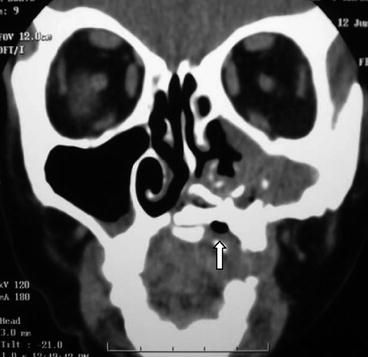Fig. 1
Coronal CT shows soft tissue opacification of the left ethmoid and maxillary sinuses. Note subtle irregularity of adjacent left lamina papyracea with minimal intraorbital fat stranding, suggesting acute invasive fungal sinusitis
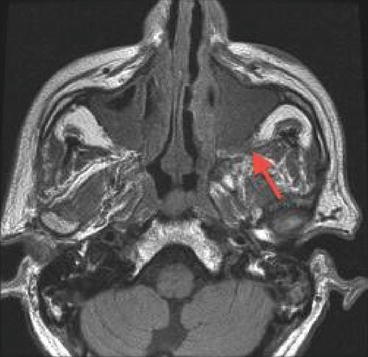
Fig. 2
MRI axial T1 image shows left peri-antral fat stranding (arrow), which may be an early sign of invasive fungal sinusitis
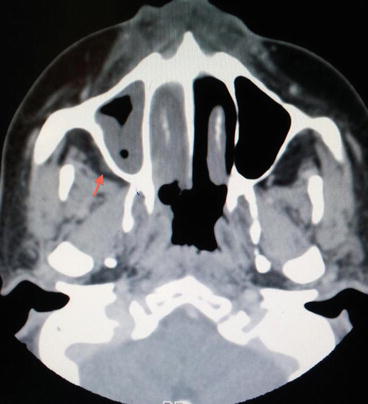
Fig. 3
Axial plain CT shows soft tissue in the right maxillary sinus. Note minimal right peri-antral soft tissue thickening (arrow), compared to left side clean hypodense peri-antral fat. This was a subtle sign, and biopsy showed invasive mucormycosis
It is mandatory to perform detailed MR imaging with multiplanar thin T1- and T2-weighted sections through the skull base, paranasal sinuses, orbits, and any other area clinically indicated, along with post-contrast study, with fat suppression. Additional high-end MRI techniques such as perfusion, diffusion, and MR spectroscopy are now being researched, for better characterization of the disease and its extent. For evaluating intracranial and intraorbital extension of the disease, MRI is superior to CT. On MRI presence of stranding in the orbital fat and swelling with T2 hyperintensity of the extraocular muscles with or without proptosis suggest intraorbital invasion (Figs. 4, 5 and 6).
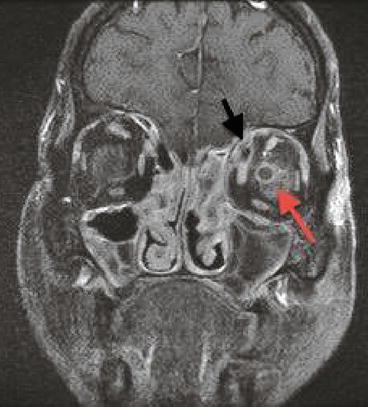
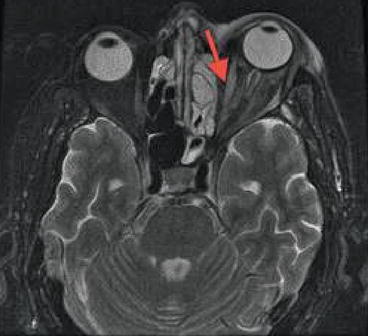
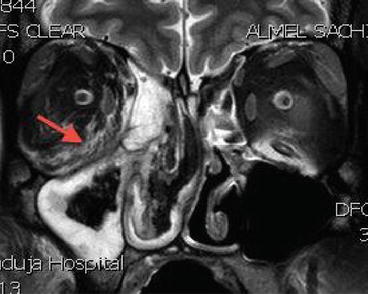

Fig. 4
MRI coronal post-contrast T1W image shows bilateral ethmoid and maxillary sinus soft tissue, with heterogeneous enhancement. Note ill-defined stranding with enhancement in the superomedial left orbital fat (small black arrow), with similar findings around the left optic nerve (red arrow), consistent with acute invasive fungal sinusitis

Fig. 5
MRI axial T2W image of the same patient shows bilateral ethmoid opacification, with diffuse fullness and hyperintensity involving the left extraocular muscles (arrow), as well as in the retro-ocular fat

Fig. 6
MRI T2W coronal image shows predominantly right-sided ethmoid and maxillary mucormycosis, with infiltration into the right orbit (arrow)
One of the signs of intracranial extension is leptomeningeal enhancement, which is better appreciated on MRI (Fig. 7). Initially leptomeningeal enhancement may be subtle, and one may really have to look for it [5]. Other findings of intracranial invasion include cerebritis, granulomas, and cerebral abscess formation. A fungal granuloma usually shows hypointense signal on both T1- and T2-weighted images, with minimal enhancement on contrast-enhanced images. At times, intracranial extension may occur directly from the sphenoid sinus into the cavernous sinus. This may lead to cavernous sinus thrombosis and sometimes infiltration into the carotid artery/occlusion, or pseudoaneurysm, causing ipsilateral large cerebral infarction. Vascular thrombosis is commonly seen with mucormycosis, seen as altered flow signal in a vessel with heterogenous enhancement. This may result in mycotic emboli and cause small abscesses, which are more commonly seen in the frontal lobes.


Fig. 7
MRI post-contrast axial T1W image shows intracranial leptomeningeal enhancement in the right frontal region (arrows), in the same patient as in Fig. 5, with advanced mucormycosis
Chronic Invasive Fungal Sinusitis
Fungi, usually, implicated in causing this type of fungal sinusitis are Aspergillus species, dematiaceous molds such as Bipolaris and Curvularia, and Pseudallescheria boydii. A non-contrast CT may show a hyperattenuating mass-like lesion mimicking a malignancy with destruction of the sinus walls [5] (Fig. 8) and extending beyond the sinus walls into adjacent structures, such as the orbit, maxillary floor/hard palate (Fig. 10 in Chapter “Clinical Features and Diagnosis”), cribriform, or pterygopalatine fossa. The sinus wall may show sclerotic changes on CT suggesting chronicity. There may also be lucencies or irregular bone destruction in the paranasal sinuses. There may also be infiltration of the peri-antral soft tissues around the maxillary sinus. Differentiating malignancy and invasive fungal sinusitis may not be possible on imaging [9, 10]. On MRI, the sinus soft tissue usually shows hypointense signal on both T1 and T2, which at times may be mistaken for air in the sinuses. Presence of iron, magnesium, and increased calcium contents are the causes of T2 shortening. The peri-sinus and intracranial spread is again better evaluated on MRI. Extension of fungal infection intracranially may lead to epidural abscess, parenchymal cerebritis or abscess, meningitis, cavernous sinus thrombosis, osteomyelitis, mycotic aneurysm, stroke, and hematogenous dissemination [5].
